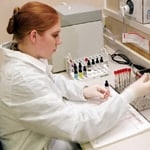
 See What Normal Blood & Urine Values Are
See What Normal Blood & Urine Values Are
 Causes Of Most Abnormal Blood & Urine Tests
Causes Of Most Abnormal Blood & Urine Tests
Your Dog Or Cat’s ACTH Stimulation Test
Ron Hines DVM PhD
Why Did My Veterinarian Suggest This Test?
ACTH test stands for adrenocorticotropic hormone test. It goes by a variety of other names. (read here) Your veterinarian uses this test to detect problems in your pet’s adrenal gland or pituitary gland function. Your pet‘s two adrenal glands are located next to its kidneys. Part of their responsibility is to produce a steroid hormone, cortisol. Cortisol is your pet’s natural hydrocortisone.
When your dog or cat produces too much cortisol, a condition called hyperadrenocorticism, also called Cushing’s disease, occurs. When your pet’s adrenal glands produce too little cortisol (and usually too little of a related hormone, aldosterone) the condition is called hypoadrenocorticism or Addison’s disease. You can read about how Cushing’s disease and Addison’s disease are verified with the ACTH test and your pet’s treatment options here and here.
Your pet’s adrenal glands are under the control of its pituitary gland. The pituitary gland is the governor of many glands. The pituitary gland produces ACTH hormone to signal your pet’s adrenal glands when they need to produce more cortisol. In this test, a synthetic form of ACTH (Cortrosyn™) is administered to your dog or cat to judge how well its adrenal glands and pituitary gland respond. Besides being responsible for signaling your pet’s adrenal glands to produce cortisol, both Cortrosyn and natural ACTH also encourages them to produce dehydroepiandrosterone (DHEAS) [for sex steroid synthesis] and aldosterone (to regulate your pet’s blood sodium, potassium and blood pressure).
In Cushing’s Disease:
Hyperadrenocorticism (too much cortisol or Cushing’s disease) is almost exclusively a disease of dogs. It is extremely uncommon for it to occur naturally in cats. When cats do show signs of Cushing’s disease, it is almost always caused by giving them high doses of corticosteroid medications (e.g. prednisolone, prednisone or Depo-Medrol®) over extended periods of time. If cats develop Addison’s disease, it is most likely due to the sudden discontinuation of those drugs.
Among dog breeds, miniature poodles, Boston terriers, beagles, dachshunds and boxers appear to develop Cushing’s disease slightly more frequently than other breeds. In most cases, a small tumor that has developed in their pituitary gland is responsible for the problem. However, for most veterinarians, the ACTH test is not the test of choice for detecting Cushing’s disease in dogs. For that, the urine cortisol:creatinine ratio screening test, followed by a low dose dexamethasone suppression test (LDDST) when the Cortisol:Cr test is positive, is preferred. The LDDST test identifies about 90-95% of Cushing’s cases in dogs. The ACTH stimulation test, only about 80-85% of the Cushing’s cases. When it is sex steroids that are being over-produced by your dog’s adrenal glands, neither test is very helpful. For that, you need the “Atypical Cushing’s test” as run by the University of Tennessee.
In Addison’s Disease:
The opposite, problem – too little natural cortisol (i.e. hypoadrenocorticism, aka Addison’s Disease aka Adrenal insufficiency) is not nearly as common in dogs as hyperadrenocorticism where too much cortisol is present. It is even less common in cats. Any breed of dog can be affected with Addison’s disease, but standard poodles, West Highland White terriers, Great Danes, Bearded collies and Portuguese water dogs lead the list. For this disease, the ACTH test is the test of choice. The classic result of the ACTH test in Addison’s disease is a very low or undetectable amount of blood cortisol before and after the synthetic ACTH dose was given.
The ACTH test can also be used to determine how effective the treatment has been for your dog’s Cushing’s disease when mitotane, (Lysodren®) or trilostane (Vetoryl®) has been given; or if the drug’s dose needs to be adjusted. Some also consider the ACTH test to be the best test for detecting the effects of over-administration of corticosteroids (=iatrogenic Cushing’s disease).
How Is This Test Performed?
There are several versions of the ACTH test. But in all of them, a blood sample from your pet is first taken before any medications are given. That will be for its baseline (“resting”) blood cortisol level determination. That initial cortisol level will probably be a bit low in dogs with poorly functioning adrenal glands (Addison’s=hypoadrenocorticism). But your veterinarian will not know if that is because of a real adrenal gland problem or due to the natural daily fluctuations in cortisol levels, or because of some non-adrenal illness. Then, a dose of synthetic ACTH product (Cortrosyn or an ACTH gel) will be injected, intramuscularly (or IV) into your pet. One to two hours later, depending on the product injected, a second blood sample will be obtained from your pet again for another cortisol level determination. At this point, dogs with Addison’s disease could be expected to show little or no rise in their cortisol level because their adrenal glands are incapable of responding to the ACTH injection.
It has been found that the Low Dose Dexamethasone Injection Test (LDDST) is more sensitive with fewer false negatives, but is less specific (more false positives) than the ACTH stimulation test in dogs with significant non-adrenal illness – especially when it is liver disease. When the ACTH stimulation test is run on dogs with Cushing’s disease, the expected result would be to have a 1-2 hour post-ACTH injection cortisol level considerably higher than before the pet received the ACTH injection and higher than the level it would rise in normal dogs. That is because the adrenal glands of Cushing’s dogs have adapted to produce higher than normal cortisol when they are stimulated by ACTH. However, the drawback with the ACTH test is that a sizable number of dogs that do have Cushing’s disease do not show that spike in cortisol after the injection of ACTH. That is particularly true if their Cushing’s disease is the result of an adrenal gland tumor. That problem makes the ACTH test only 60-90% effective in detecting dogs with Cushing’s disease. That is also the reason why most veterinarians prefer to administer the LDDST test which is often more easily interpreted. The LDDST test also has an advantage in that it can pick up clues as to whether your dog has an adrenal tumor or a pituitary gland tumor (30%-50% of the time it is able to do that correctly). In dogs, pituitary gland tumors greatly exceed adrenal gland tumors as the underlying cause of the Cushing’s problem. Dogs with normal adrenal gland function should have moderately increased cortisol blood levels in the 1-hour post-injection sample. But their increase will be considerably less than in dogs with Cushing’s disease.
Dehydration, prior administration of corticosteroid medication or certain medications (e.g. mitotane, trilostane or ketoconazole) can invalidate your dog’s test results when it is being used to diagnose Addison’s disease. But it will confirm that those medications have been effective in reducing your pet’s adrenal gland function in Cushing’s disease – if that was your veterinarian’s intended use of the test. Stress can invalidate or affect the test results too; so can lipemic, turbid, hemolyzed or elevated bilirubin blood samples.
The synthetic ACTH products that your veterinarian must inject have become very pricey. So, your veterinarian might use a low dose ACTH test that has been developed to keep that cost down. It appears to be equally as good as the older standard-dose method.
Veterinarians at Mississippi State and Purdue universities determined that a single blood assay of the pet’s Cortisol-to-ACTH Ratio was an effective way to diagnose Addison’s disease (hypoadrenocorticism or low cortisol). But currently I know of no laboratories offering that test.
DxMe
You are on the Vetspace animal health website
Visiting the products that you see displayed on this website help pay the cost of keeping these articles on the Internet.

